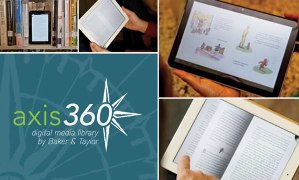 Baker & Taylor announced on May 22 that the latest release of its Axis 360 digital media platform includes accessibility functions that will allow visually-impaired patrons to use a library’s digital collections. The platform is now compatible with several leading assistive screen-reader technologies, including JAWS (Job Access with Speech), Window-Eyes, NVDA (non-visual desktop access) and System Access To Go.
Baker & Taylor announced on May 22 that the latest release of its Axis 360 digital media platform includes accessibility functions that will allow visually-impaired patrons to use a library’s digital collections. The platform is now compatible with several leading assistive screen-reader technologies, including JAWS (Job Access with Speech), Window-Eyes, NVDA (non-visual desktop access) and System Access To Go.
“Libraries take their commitment to serve their entire community very seriously, and this new version of Axis 360 helps them meet the needs of all their customers,” George Coe, president of Library and Education at Baker & Taylor, said in a release.
The company worked with the National Federation of the Blind (NFB) to develop the new platform, and in the press announcement, Dr Marc Maurer, president of NFB, said that his organization would “certainly work with libraries across the country to ensure that they fully exploit what Axis 360 can uniquely offer.”
With ebooks becoming increasingly popular, NFB has taken a keen interest in ensuring that the rapidly growing format remains accessible to the visually impaired. Earlier this month, the group helped four blind patrons sue the Free Library of Philadelphia over a program that loans Nook Simple Touch ereaders to patrons over 50.
In their suit, the plaintiffs claim that the library violated the Rehabilitation Act of 1973, the Americans with Disabilities Act, and the policies of the American Library Association and the Institute of Museum and Library Services by choosing to purchase and lend Nooks, which currently lack accessibility features for the blind, rather than ereaders with accessibility features.
In response to the suit, earlier this month the Board of the Association of Research Libraries established a Joint Task Force on Services to Patrons with Print Disabilities. The goal of the task force will be to help ARL member libraries and their parent institutions “be informed advocates for accessibility and position themselves to comply with necessary requirements,” specifically with regard to electronic resources including ereaders, licensed e-resources, mobile devices, websites, scanners, and copiers, ARL wrote in an announcement. The task force is expected to complete its work in six months, with a program briefing planned for the ARL Membership Meeting in October.


